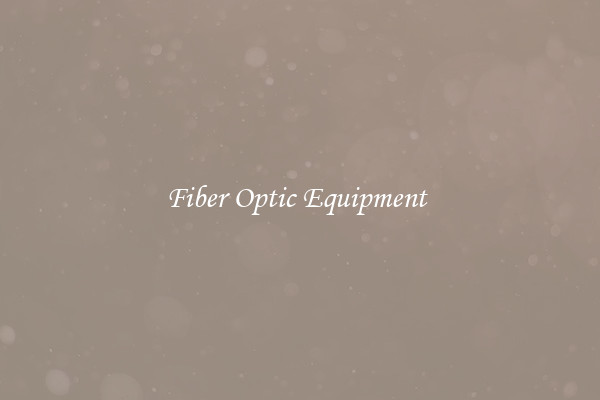Fiber Optic Equipment
Fiber optic equipment has revolutionized the world of telecommunications, enabling faster and more reliable data transmission than ever before. This cutting-edge technology has become an integral part of our daily lives, powering our internet connections, phone networks, and even cable TV systems. From its inception to its widespread adoption, fiber optic equipment represents a milestone in the history of communication.

At its core, fiber optic equipment consists of thin strands of glass or plastic, known as optical fibers, which are capable of transmitting data over long distances at the speed of light. These optical fibers are bundled together in cables, along with other supporting components such as connectors, transmitters, and receivers. Together, they form a sophisticated network of interconnected devices that enable data to be transmitted over vast distances with minimal signal loss.
One of the main advantages of fiber optic equipment is its incredible bandwidth capabilities. Unlike traditional copper-based cables, which have limited capacity, fiber optic cables can transmit a significantly larger amount of data over the same distance. This attribute makes fiber optics ideal for delivering high-speed internet connections, allowing users to stream HD videos, engage in video conferences, and download large files seamlessly.
Another key feature of fiber optic equipment is its immunity to electromagnetic interference. Unlike copper cables, which are susceptible to disruptions caused by nearby electrical devices, fiber optic cables are made of non-conductive materials that are impervious to electromagnetic disturbances. This makes fiber optics more reliable and less susceptible to data loss or degradation, ensuring consistent and high-quality transmission.
Furthermore, fiber optic equipment offers enhanced security for data transmission. As data is transmitted through light pulses, it is extremely difficult to intercept or tap into fiber optic cables without raising alarms. This makes fiber optics the preferred choice for industries that require secure communication channels, such as banking, healthcare, and government agencies.
The deployment of fiber optic equipment has been instrumental in bridging the digital divide and enabling connectivity in remote and underserved areas. With fiber optics, internet service providers can deliver high-speed internet to communities that were previously left behind, facilitating access to educational resources, job opportunities, and digital services.
In conclusion, fiber optic equipment has transformed the way we communicate and access information. Its remarkable speed, reliability, and security have made it a cornerstone of modern telecommunications infrastructure. As the demand for faster and more reliable connectivity continues to grow, fiber optic equipment will play an increasingly vital role in shaping the future of communication networks.

View details

View details

View details

View details








